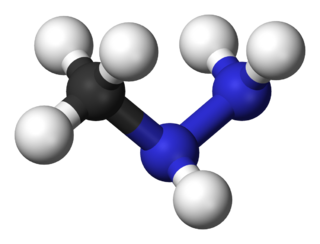Metilhidrazina
| Monometilhidrazina | ||
|---|---|---|
  | ||
 | ||
| Nombre IUPAC | ||
| Methylhydrazine | ||
| General | ||
| Fórmula semidesarrollada | CH3N2H3 | |
| Fórmula estructural |
 | |
| Fórmula molecular | ? | |
| Identificadores | ||
| Número CAS | 60-34-4[1] | |
| Número RTECS | MV5600000 | |
| ChEMBL | CHEMBL160520 | |
| ChemSpider | 5837 | |
| PubChem | 6061 | |
| UNII | UWA30B5Z1J | |
| Propiedades físicas | ||
| Densidad | 880 kg/m³; 0,88 g/cm³ | |
| Masa molar | 46.07 g/mol g/mol | |
| Punto de fusión | −52 °C (221 K) | |
| Punto de ebullición | 87 °C (360 K) | |
| Propiedades químicas | ||
| Solubilidad en agua | Soluble | |
| Producto de solubilidad | soluble en alcohol y ether | |
| Peligrosidad | ||
| SGA |
     } } | |
| NFPA 704 |
4
4
4
| |
| Temperatura de autoignición | 469 K (196 °C) | |
| Frases H | H225,H300,H311,H314,H330,H351,H411 | |
| Frases P | P210,P260,P273,P280,P284 | |
| Riesgos | ||
| LD50 | 32 mg/kg(oral, ratas) | |
| Valores en el SI y en condiciones estándar (25 ℃ y 1 atm), salvo que se indique lo contrario. | ||
La metilhidrazina, también conocida como monometilhidrazina (MMH), es una hidrazina volátil la fórmula química CH3N2H3. Se utiliza como combustible de cohete en motores de cohete bipropelentes.
La MMH tiene aplicaciones en los motores OMS (sistema de maniobra orbital) del transbordador espacial de la NASA. El compuesto es tóxico y cancerígeno, pero su almacenamiento en el espacio es fácil proporcionando un rendimiento moderado para pesos de almacenaje y mantenimiento muy bajos. Recientemente la Agencia Espacial Europea ha tratado de encontrar nuevas opciones, en términos de combinaciones propelente/oxidante, para evitar que se usen químicos venenosos como este y sus derivados.[2]
LA MMH y su derivado la 1,1-dimetilhidrazina (UDMH) tienen una ventaja, son lo suficientemente estables para usarlos en motores de cohete refrigerados constantemente.
También se encuentran trazas en el Agaricus bisporus crudo (el champiñón común) en tiendas de comestibles, y en la mayoría de miembros de las setas género Gyromitra. En particular es relativamente frecuente encontrarla en la falsa colmenilla (Gyromitra esculenta).
Véase también
[editar]Notas
[editar]- ↑ Número CAS
- ↑ International Conference on Green Propellant for Space Propulsion Archivado el 23 de diciembre de 2009 en Wayback Machine., European Space Agency
Fuentes
[editar]- Sutton, Biblarz; Rocket Propulsion Elements 7th. Edition; p. 244, 258; Wiley-Interscience Publication; 2001
- L. Catoire et al. Journal of Propulsion and Power, Volume 22, N°1, pp. 120-126 (2006)
Text is available under the CC BY-SA 4.0 license; additional terms may apply.
Images, videos and audio are available under their respective licenses.

